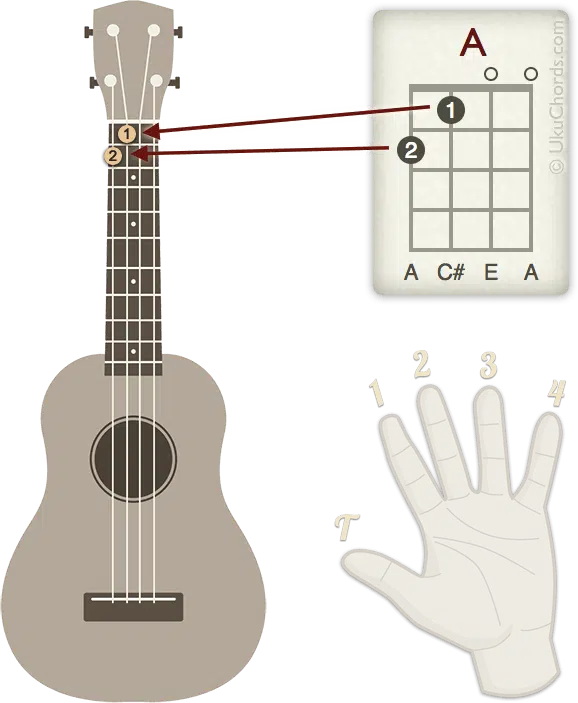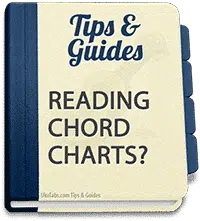When you are just starting out with the ukulele it can be quite overwhelming to look at all the different chords and their shapes. Luckily, you can easily learn how to read ukulele chord diagrams.
How to read ukulele chord diagrams? It’s really easy!
The ukulele chord diagrams are quite intuitive to understand, but some symbols may need some explaining. Once you know how the chord diagrams work you will be glad to see them on song pages, because it will really help you learn a song faster. Read on to learn how to read ukulele chord diagrams.
A picture is worth a thousand words

Chord diagrams (as seen on UkuTabs)
1. The basics
The UkuTabs chord diagrams are quite easy to understand and I’ve made them as simple as possible. You should imagine there is a ukulele in front of you and you are looking at the fretboard with the headstock at the top. The strings are illustrated as vertical lines (from left to right G C E A string) and the frets are the horizontal lines.
All the different chord shapes are represented by dots. Each dot represents the placement of your finger. In the example on the right, you can see a G chord. So how should you place your fingers? You play the C string at the second fret, the E string at the third fret and the A string at the second fret. That little circle (o) at the top of the G string means that you have to play that string open (i.e. not place a finger on it).
This is a basic chord diagram and most of time you will see diagrams like this. However, there are a few symbols that need some explaining. Once you get the hang of them, you will know how to read ukulele chord diagrams.
2. Higher up the fretboard
Sometimes you will see numbers at the sides of diagrams. These refer to a certain fret number, because sometimes a chord is played higher up the fretboard (if there are no numbers, it means frets 1 to 4 are shown). In the example on the right, the G, C and A strings are played at the sixth fret and the A string at the eighth fret.
3. Muting
If you see a little “x” at the bottom (or top) of a string it means you should not play that string at all. In other words, you have to mute it. You can do this by resting one or more of your fretting fingers on the string without actually fretting it. An example is shown on the right.
Text chords
Sometimes you won’t see chord diagrams in the score for a song, but only four simple numbers. Sometimes people talk about chords this way as well. For example, “0232” represents a G chord. The four numbers refer to each string of the ukulele (order: GCEA). This is incredibly useful to tell someone quickly how to play a certain chord. The second example in this guide would be 6668 and the third one X124.
UkuChords chord charts
Discover the complete ukulele chord charts for soprano, concert and tenor ukuleles. It features all the main chord diagrams, and you can either download a print-friendly pdf or a “poster-like” chart.
Need more input on how to read ukulele chord diagrams?
I hope this guide has helped you learn to read ukulele chord diagrams.
Feel free to contact me whenever you need more information.
Interested in checking out the ultimate ukulele strumming guide?
